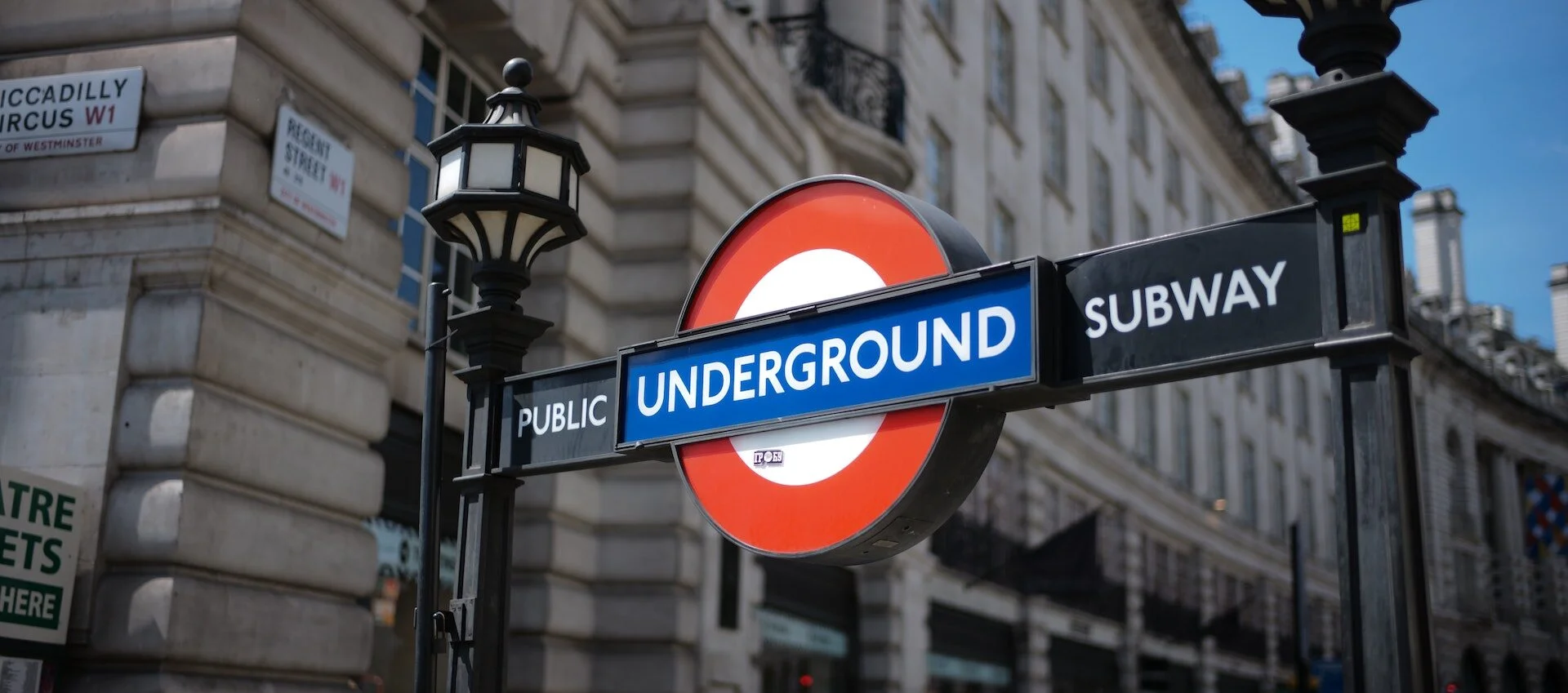An Interesting Fact About Every London Tube Station
The London Underground.
It’s a Monument to our capital’s history. It’s Morden adequate for the job it was designed for. You can Bank on it.
Can’t Stanmore of these puns? Well rest assured, they’re terminating here. And in their place, we’d like to merely list one interesting fact about each of the 270 tube stations on the London underground network.
HERE THEY ARE, LINE BY LINE:
Bakerloo Line
Central Line
Circle Line
District Line
Hammersmith & City Line
Jubilee Line
Metropolitan Line
Northern Line
Piccadilly Line
Victoria Line
OR, IN ALPHABETICAL ORDER:
Acton Town
Alphabetically, the first tube station on the network! We’re off to a roaring start.
–
Aldgate
Is built directly on top of a vast plague pit, where thousands of bodies are apparently buried. No-one knows quite how many.
–
Aldgate East
This tube station was moved by just a few feet in 1938 in order to make the curve of the track slightly more gentle. In order to do this, the entire track had to be lowered by 2m in one night. The ground below the track was excavated during the day (with the rails held up by a wooden trestle while trains still ran over them), and 900 workmen simultaneously eased the rails down after the station closed. It reopened the next morning with no break in service.
–
Alperton
Has the only remaining wooden escalators on the network, bricked up behind a wall.
–
Amersham
The highest tube station on the network, at a solid 147m above sea level (and well worth a visit; the chocolate box village of Amersham is one of the loveliest – and easiest – day trips from London you can make).
–
Angel
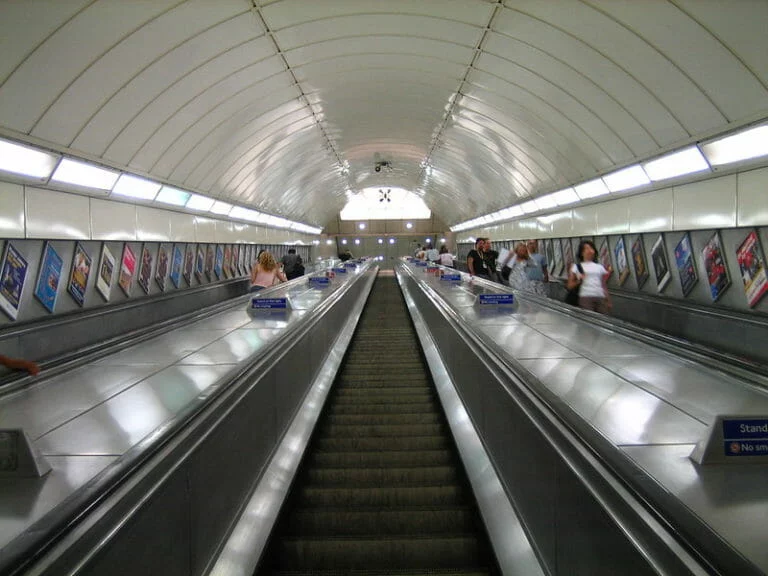
Simon Laird / Flickr
Has the Underground’s longest escalator at 60m/197ft, with a vertical rise of 27.5m. In fact, it’s the 4th longest in Western Europe. It’s also named after an old pub that used to stand on the junction above ground in the 17th century.
–
Archway
Hidden in the green & cream tiling pattern at Archway station, there are black arches (as in ‘arch’ way).
–
Arnos Grove
The design of the station – which is Grade II listed – was inspired by the Stockholm Public Library.
–
Arsenal
The only tube station to be named after a football team – which was, weirdly, itself named after its original home… down in Woolwich Arsenal.
–
Baker Street
Has the most platforms of any tube station – 10.
–
Balham
Balham is the only Underground station that doesn’t have any of the letters of the word ‘underground’ in it.
–
Bank
Has the most entrances/exits of any tube station with 12.
–
Barbican
The tube’s first rail disaster happened here – 4 people died in 1866 and the trains were running again within half an hour.
–
Barking
Currently has a direct freight service running 7,500 miles direct to & from the city of Yiwu, on China’s east coast.
–
Barkingside
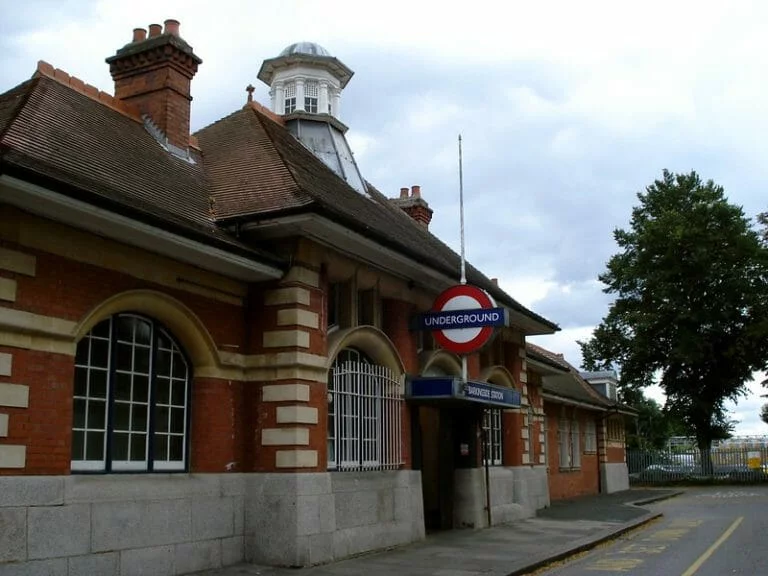
Kake / Flickr
Is the only tube station on the network with an ornate, medieval-style hammerbeam roof (usually only used in great halls or cathedrals).
–
Barons Court
Mahatma Gandhi lived at 20 Barons Court Road, a few yards from the station, while studying law. It’s also the only tube stop to have benches sporting the station’s name.
–
Bayswater
Was originally called Queen’s Road (Bayswater), but the name was changed to avoid confusion with Queensway, which was also called Queen’s Road. And the kicker? There is no Queen’s Road in Kensington.
–
Becontree
When Becontree was first built in the interwar period, it was the largest housing estate in the world – and a railway station was built specifically for it.
–
Belsize Park
Belsize Park has a sign claiming that the stairs have 219 steps, but there are actually 189. It’s not clear why they lie about it.
–
Bermondsey
The architects have cleverly designed the station so that natural light makes it all the way down to platform level, 10m below the entrance above ground.
–
Bethnal Green
Not exactly a ‘fun’ fact, but this was the site of the single largest loss of civilian life in the UK during WW2. 173 people lost their lives during a stampede while using the space as an air raid shelter. News of the disaster was suppressed on orders of Churchill himself until the end of the war.
–
Blackfriars
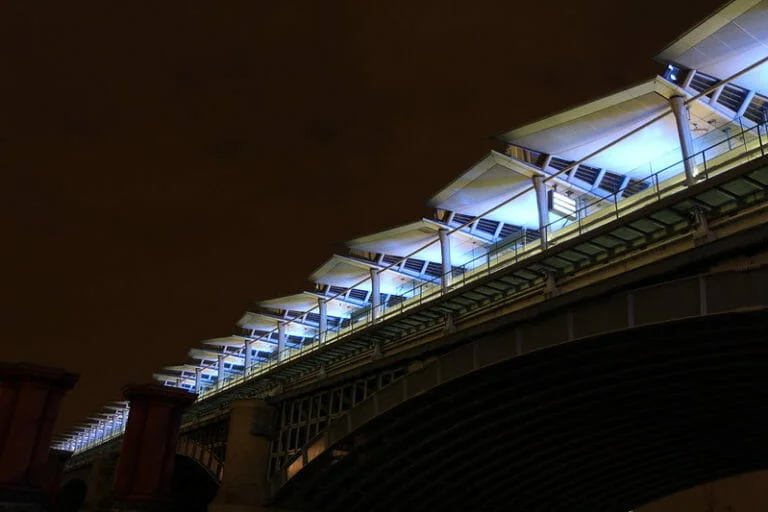
Jonathan Beeston / Flickr
In January 2014 the Blackfriars Railway Bridge became the world’s largest solar-powered bridge, having been covered with 4,400 photovoltaic panels providing up to half of the energy for the station.
–
Blackhorse Road
Despite the black horses depicted in station murals, it’s actually named after a nearby black house.
–
Bond Street
Harry Selfridge drew up proposals for a direct subway connecting the station to his store, and for the station to be renamed ‘Selfridges’. The proposals were declined.
–
Borough
As an architectural shortcut, it was essentially a replica of Kennington station when it was first built.
–
Boston Manor
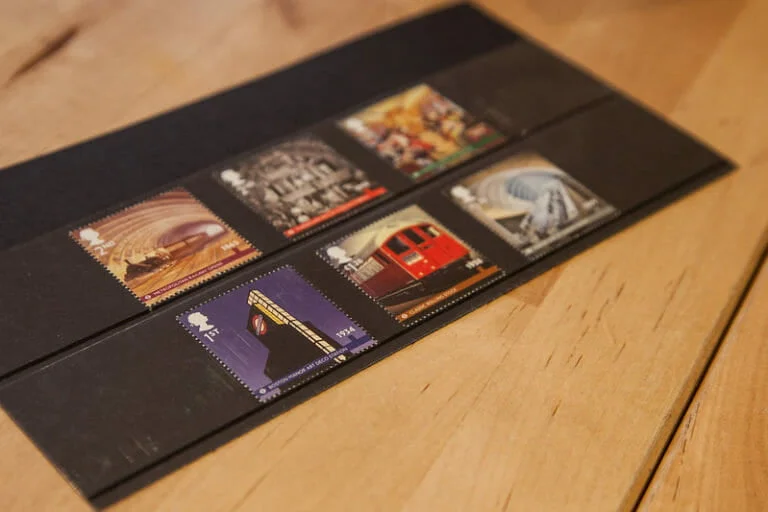
Tom Page / Flickr
Thanks to its Art Deco design, the station appeared on a postage stamp in 2013. The architect, Charles Holden, designed several tube stations in the 30s, as well as the Underground’s huge HQ building above St. James’s Station.
–
Bounds Green
Name-dropped in the lyrics to Has it Come to This? by The Streets.
–
Bow Road
The steepest gradient on the tube network at 3.6%. Insanity.
–
Brent Cross
Brent Cross station was named after the shopping centre when it opened nearby in 1976, not the other way around. Bet Harry Selfridge’s ghost is livid.
–
Brixton
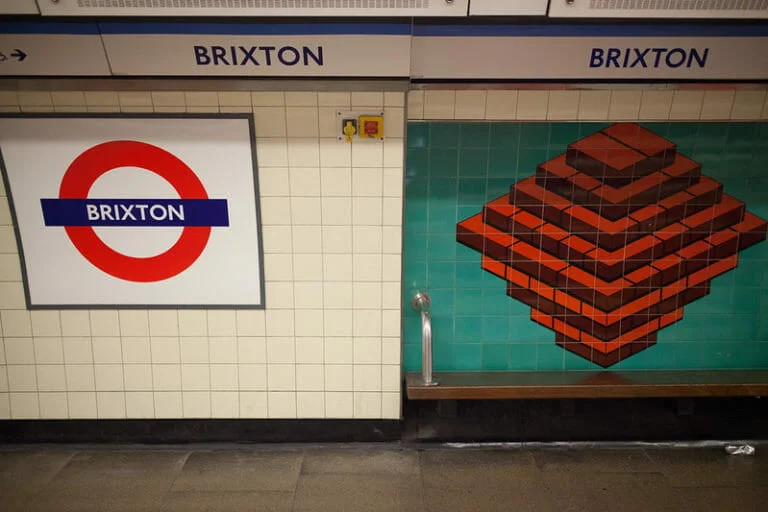
Tom Page / Flickr
There’s a mural in the station of a pyramid of bricks, which is a visual pun of a ton of bricks (or a ‘bricks ton’).
–
Bromley-by-Bow
In EastEnders, the fictional Walford East tube station takes the place of Bromley-by-Bow.
–
Buckhurst Hill
The only through-station in zones 1 to 6 on the Underground to be in a zone on its own – passengers travelling from the station leaving in either direction must cross a zone boundary.
–
Burnt Oak
The first ever Tesco was opened just down the road from this tube station, in 1929. The tins had no labels to keep costs down.
–
Caledonian Road
Named after an asylum for Scottish children built nearby in 1828. Not as in mental asylum, but as in safe asylum. To be clear.
–
Camden Town
Because the station is so busy at weekends with people flocking to Camden Market, TfL are planning on rebuilding a new entrance on Buck Street… buuut the insane cost of HS2 has put the plans on hold indefinitely.
–
Canada Water
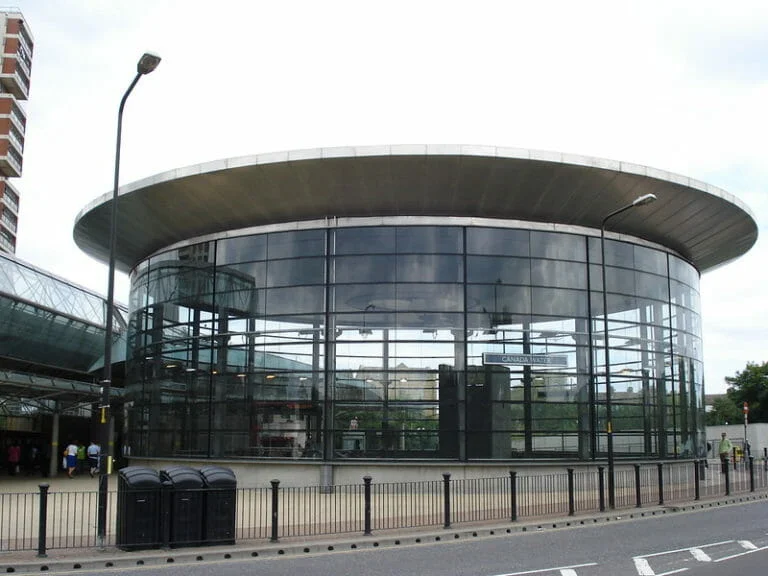
Kake / Flickr
Designed by the same architect as the Millennium Dome. Who was clearly copying his own homework.
–
Canary Wharf
The busiest tube station to serve a single line, and it’s had at least one wedding celebrated in it.
–
Canning Town
There was another Canning Town station north of Barking road, but when the DLR came along, instead of adding a platform to the existing station, they simply demolished the whole thing and built a new one from scratch.
–
Cannon Street
The name first appears as ‘Candelwrichstrete Street’ in 1190. The name was shortened over 60 times, and eventually settled on Cannon Street in the 17th century. It is therefore not related to the firearms.
–
Canons Park
Named after Cannons, a vast house built on the site in 1724 at the cost of £28m (adjusted for inflation). It was demolished and sold off brick by brick 20 years later. And therefore not related to the firearms, either.
–
Chalfont & Latimer
The longest single journey between neighbouring stations: 9 mins on average to Chesham.
–
Chalk Farm
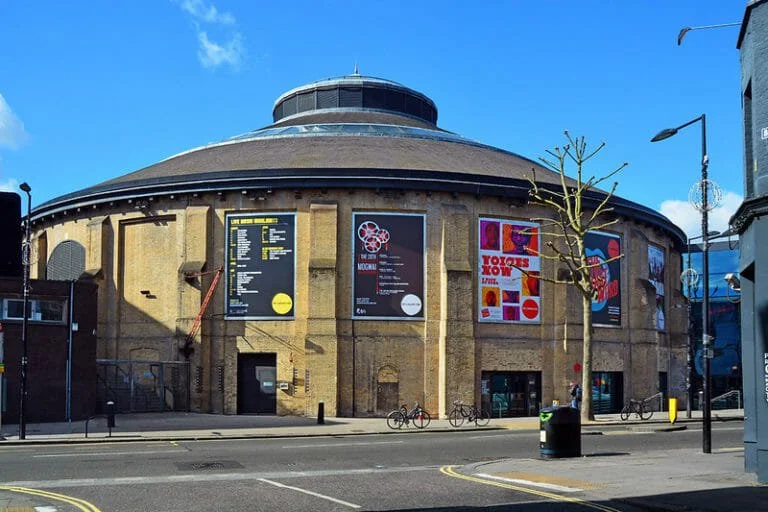
George Rex / Flickr
The Roundhouse next door used to be a railway turntable servicing the station.
–
Chancery Lane
In the ’70s, the former air raid shelter built underneath the station was turned into a telephone exchange with 200 staff, its own restaurant, bar, and games room, all 200ft below the surface.
–
Charing Cross
Modern day Charing Cross is an amalgamation of two old stations: Trafalgar Square and Strand.
–
Chesham
Furthest away from any other tube station, at 3.8 miles to the nearest neighbour.
–
Chigwell
Serves the town of Chigwell, which Charles Dickens described as “the greatest place in the world”.
–
Chiswick Park
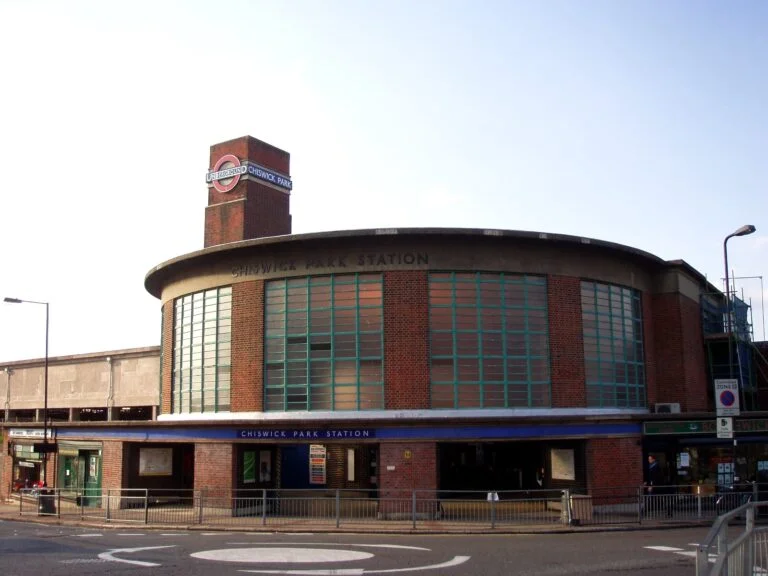
Ewan Munro/Flickr
Once known as Acton Green – the name was changed due to there being seven other Acton stations already.
–
Chorleywood
The name literally means “peasant’s wood” (and currently has one of the highest quality of life ratings in the country).
–
Clapham Common
For 2 weeks in September 2016, all of the adverts used in the station were replaced by photos of cats.
–
Clapham North
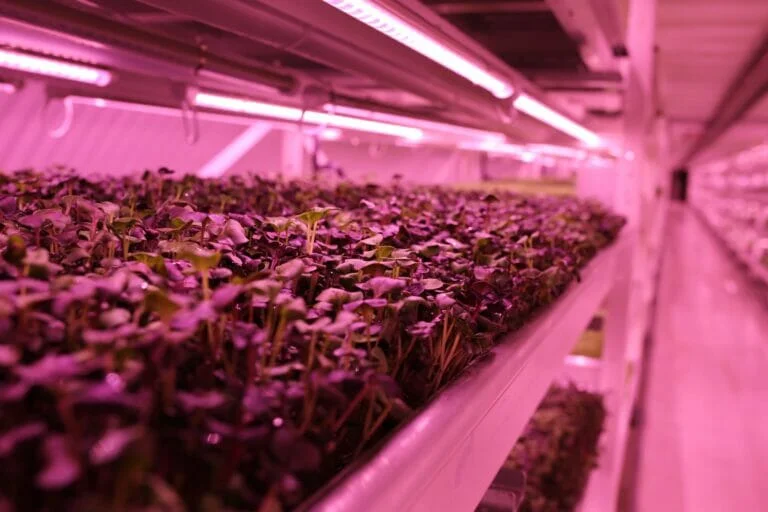
Abandoned tunnels connected to Clapham North tube station, once used as a deep level bomb shelter, are now home to Growing Underground, a farm growing salad leaves and herbs beneath the pavements of Clapham.
–
Clapham South
The station was originally to have been called ‘Nightingale Lane’, and this name still exists hidden behind the blue bars on the platform roundels.
–
Cockfosters
Being the final/first station on the line, it has a tunnel designed to mirror the one at Uxbridge at the opposing end of the line.
–
Colindale
Was frequently used by T.E. Lawrence (AKA Lawrence of Arabia), who used the pen name ‘Colin Dale’ during his journalistic career.
–
Colliers Wood
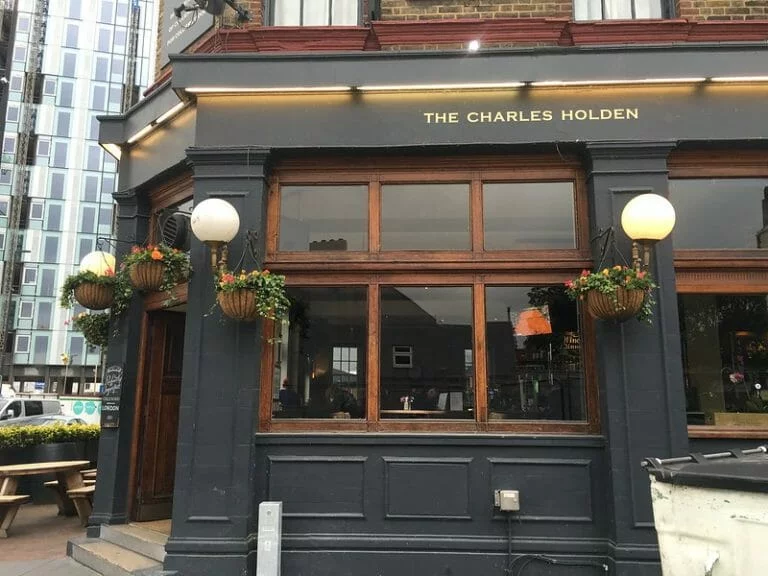
Secret London 123 / Flickr
The pub opposite is named after the architect who designed the station itself, Charles Holden. In fact, he designed a great many stations in his time.
–
Covent Garden
London Underground’s standard £4.80 single cash fare for the journey between here and Leicester Square equates to £29.81 a mile, making the fare for this particular journey more expensive per mile than the Orient Express.
–
Croxley
A story is told of how a year after the tube station opened in 1926, a group of ladies was directed to it by Croxley’s policeman P.C. Haggar. He bade them a cheery “Good-night” – to learn shortly afterwards that they were a band of suffragettes who had set fire to the new station.
–
Dagenham East
Was the site of a rail crash in 1958 due to fog – and the train that caused it is still active on the Severn Valley Railway.
–
Dagenham Heathway
Despite being smaller, and having fewer platforms, gets twice the number of passengers per year as Dagenham East.
–
Debden
Debden tube station was the setting for the Victorian ballad “The Chigwell Stationmaster’s Wife”. Not Chigwell.
–
Dollis Hill
Dollis Hill played a part in the Second World War, as the code-breaking computer used at Bletchley Park was built here.
–
Ealing Broadway
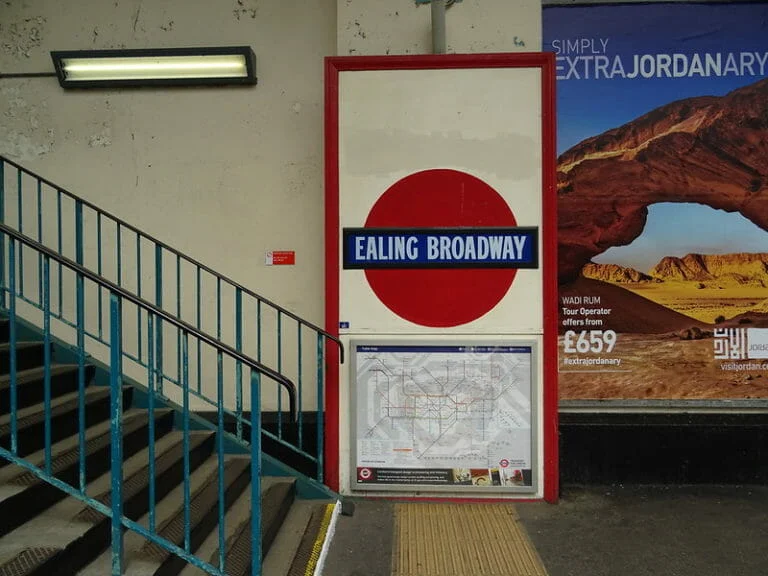
Andy Aldridge / Flickr
Platforms 8 & 9 still contain some of the pre-roundel logo designs.
–
Ealing Common
Has a heptagonal ticket hall, one of only two on the network.
–
Earl’s Court
The site of the last remaining blue police telephone box – radios took over in the 1970s.
–
East Acton
Not actually in the borough of Acton, it just took the name to be part of the trend – there are seven Acton stations on the network.
–
East Finchley
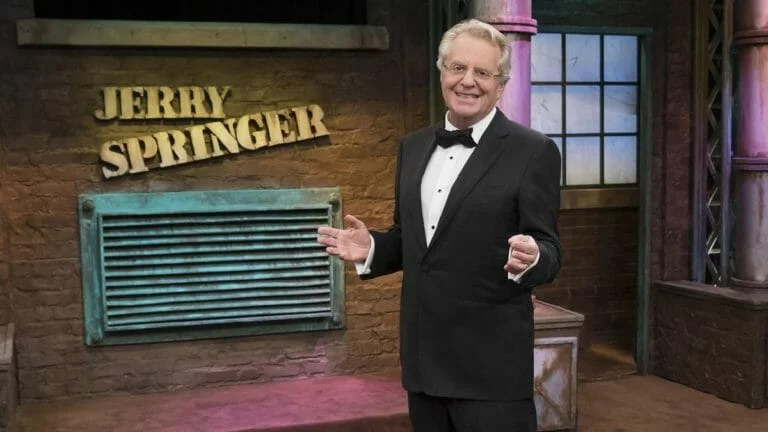
Jerry Springer was born in the station during an air raid in WW2.
–
East Ham
Between 1851 when the tube station was built, and 1911, East Ham’s population grew by 7585%.
–
East Putney
On 1 April 1994, East Putney was sold to London Underground for the princely sum of £1.
–
Eastcote
Was originally called Ascot.
–
Edgware
Was supposed to connect to Mill Hill East, and you can still see the disused track that leads to it…
–
Edgware Road
Has a “living wall” wall of plants outside the station, the only one in the underground network.
–
Elephant & Castle
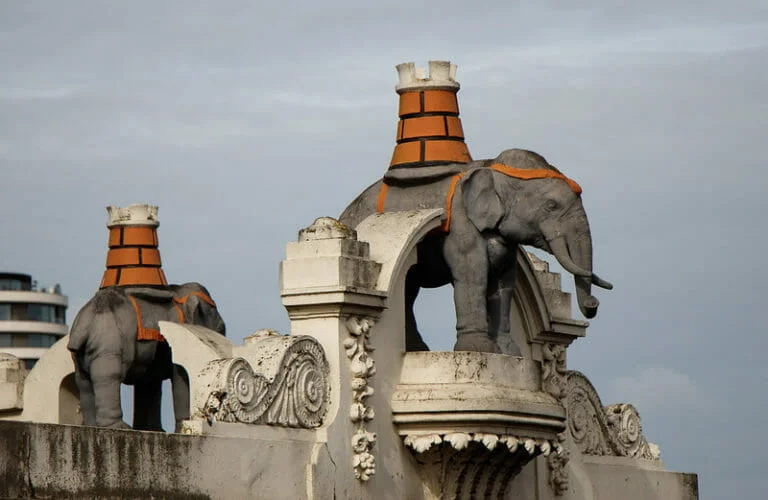
Tim White / Flickr
Named after a nearby pub, which itself was name-dropped in Shakespeare’s Twelfth Night.
–
Elm Park
Celebrations to mark the opening of the tube station in 1935 included a performance by the Dagenham Girl Pipers – they performed in Nazi Germany around the same time, and Hitler is said to have remarked: “I wish I had a band like that.”
–
Embankment
Has a huge, empty substation attached to it, abandoned since 1957. Called ‘Pages Walk’ it’s behind a blast door in the station, and is so large it’s been proposed as a possible nightclub location.
–
Epping
Has the largest public London Underground station car park with 519 spaces. It’s usually still full by around 6.30am each day though.
–
Euston
Has a bench made from 450 million year old stone outside of it.
–
Euston Square
Was the place that the very first piece of work on the underground – or any underground railway on earth – took place. A shaft was sunk in January 1860 there.
–
Fairlop
Steam trains ran through this station until 1947, and it became part of the Central line the following year.–
Farringdon
Originally designed to transport livestock to Smithfield market – there’s still a cattle ramp onto the street West Smithfield for this purpose, and it’s grade II listed.
–
Finchley Central
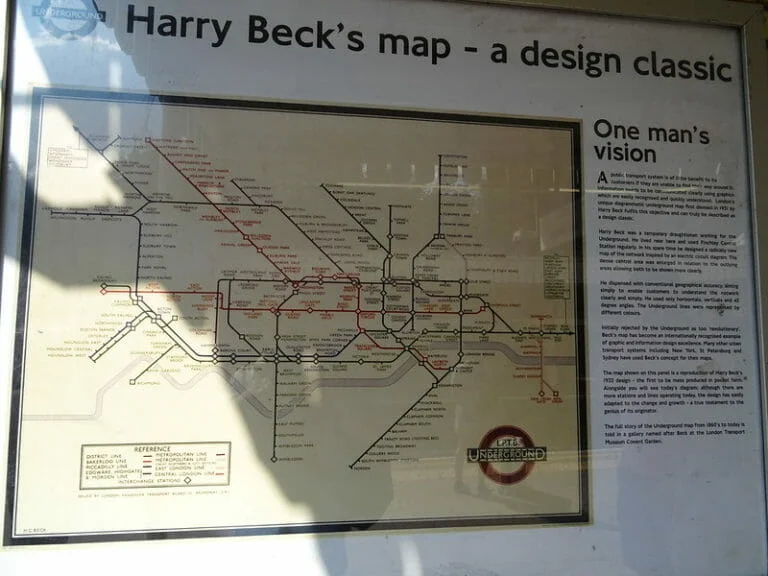
Andy Aldridge / Flickr
Has an original copy of the Harry Beck Tube map on display; he lived nearby and used the station frequently.
–
Finchley Road
Analysis of earth removed when tunnelling towards the station revealed that its site was the southern limit of a glacier which covered Britain in one of the Ice Ages.
–
Finsbury Park
Due to confusion with popular duelling site Finsbury Field, when it opened the station was decorated with mosaics of duelling pistols. They’re still there today.
–
Fulham Broadway
It’s the station in 1998’s Sliding Doors, where reality changes because of a missed train.
–
Gants Hill
One of the two theories about the origin of the name? It was originally a swamp filled with annoying, buzzing gnats. A printing error in a map of the area led to ‘Gnats Cross’ becoming Gants Cross. Then a little light religious discrimination led to ‘Gants Cross’ becoming ‘Gants Hill’.
–
Gloucester Road

Ian Wright / Flickr
Has a disused platform that’s used as a permanent art exhibition. (…Technically making it a used platform?)
–
Golders Green
Was the last station on the Northern line to retain semaphore signals, replaced in 1950.
–
Goldhawk Road
The line running through Goldhawk Road station was active as early as 1864, yet no tube station opened there until 1914.
–
Goodge Street
Not actually on Goodge Street – it’s closer to both Tottenham Court Road and Whitfield Street.
–
Grange Hill
Destroyed by a V1 “doodlebug” bomb during WW2.
–
Great Portland Street
Despite having three lines run through it, it only has one pair of tracks, making it one of the most intensely used parts of the network.
–
Green Park
Named after the park, which itself is said to have originally been a swampy burial ground for lepers from nearby St James’ hospital.
–
Greenford

Stephen Cannon / Flickr
Used its original, century-old wooden escalator right up until 2014.
–
Gunnersbury
On 8 December 1954 the station was damaged by a tornado which ripped off the roof and injured six people.
–
Hainault
The lifts are the shallowest on the London Underground network, having a descent of just 0.67 metres.
–
Hammersmith
Technically, it’s two stations – one District/Piccadilly, one Hammersmith & City/Circle. And to get from one to the other without walking would require a minimum of 10 stops and 3 changes.
–
Hampstead
The deepest station on the line, at 58m below ground – that’s more than Nelson’s Column.
–
Hanger Lane

Ewan Munro / Flickr
In a reversal of most other stations, it has to be entered underground, but the station itself is entirely above ground.
–
Harlesden
Is almost twice as far away from Harlesden town centre as Willesden Junction is.
–
Harrow & Wealdstone
Technically the oldest tube station on the network: the mainline station was built in 1837, predating Baker Street by 24 years. It was opened for Underground trains in 1917.
–
Harrow-on-the-Hill
It’s actually on Green Hill, north of Harrow Hill.
–
Hatton Cross
On its opening in 1975, Hatton Cross was the high water mark of the network, with 279 active stations on the London Underground; the number of stations in the network has since decreased to 270.
–
Heathrow Terminal 4
It is the only station on the network to have one-way train service.
–
Heathrow Terminal 5
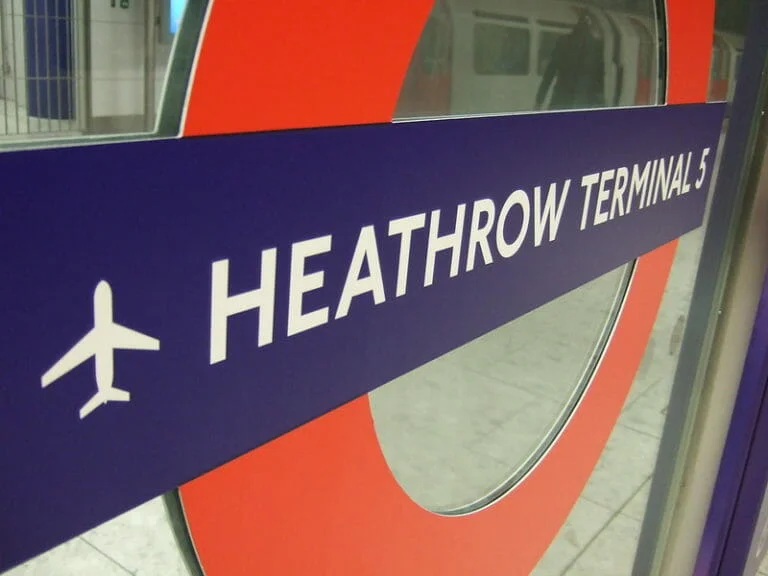
James Cridland / Flickr
Despite being underground, the ceiling is made from laminate panels, allowing natural daylight to illuminate it.
–
Heathrow Terminals 1, 2, 3
Back when it opened in 1977, it was the first time that an airport had been directly served by an underground railway system.
–
Hendon Central
When it was first built, Hendon Central tube station was surrounded by fields – the town was essentially constructed around it.
–
High Barnet
Is situated on the hill that’s thought to be the inspiration for the nursery rhyme The Grand Old Duke of York.
–
High Street Kensington
Once had a waiting room for passengers who didn’t fancy the platform. This was changed into a break room for drivers.
–
Highbury & Islington
Despite being hit by a V-1 flying bomb during WW2, the original station building stayed in use until it was demolished in 1960.
–
Highgate
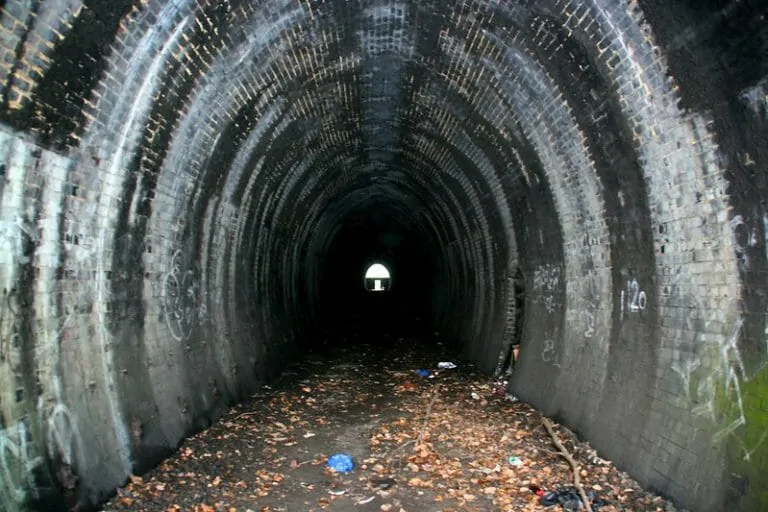
David Jones / Flickr
The disused platforms and tunnels have sometimes been used for filming and have appeared in several productions including EastEnders and Waking the Dead.
–
Hillingdon
The name Hillingdon is Middle English, and means “Hill’s hill”.
–
Holborn
Was used to store British Museum treasures during WW2. A newspaper even offered a cash reward to anyone who dared spend the night there in the ’60s amid rumours of a mummy ghost – nobody took them up on it.
–
Holland Park
Built with a flat roof in order for a retail unit to be built on top of it. 122 years later, there is still no retail unit.
–
Holloway Road
Used to have a spiral escalator (which is now stored in the Acton depot of the London Transport Museum).
–
Hornchurch
In the 80 years since the station was built, Hornchurch’s population increased by 43 times.
–
Hounslow Central
Replaced Hounslow Town tube station, which was open for just three years.
–
Hounslow East
In the 1700s, the nearby heath was notorious for successful highwaymen – which is a neat coincidence, because Hounslow East is a perfect anagram for ‘outlaws shone’.
–
Hounslow West
Due to the nearby military barracks, Winston Churchill used to frequent this station.
–
Hyde Park Corner
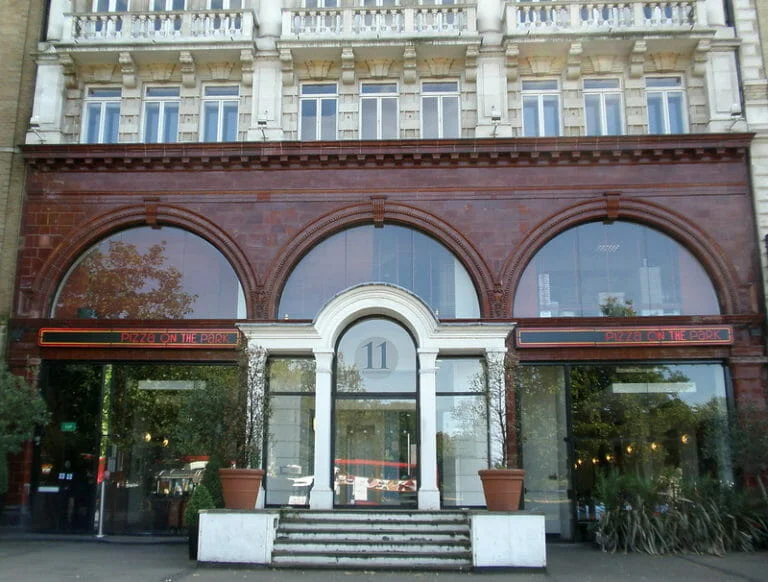
Amanda Slater / Flickr
The station is located entirely underground, with no surface presence – though there is an old station building that has since been used as a pizza restaurant and a hotel. The lifts from that building are now ventilation shafts.
–
Ickenham
Said to be haunted each Christmas since the ’50s by a woman in a red scarf, who was electrocuted there. She flails her arms, apparently.
–
Kennington
Stay on a southbound Northern line train terminating at Kennington and you’ll go round in a loop, arriving back at Kennington and heading north. People who are drunk/asleep have been known to end up in Edgware, rather than in Morden.
–
Kensal Green
In December 2006, the station was hit (or at least grazed) by a tornado.
–
Kensington (Olympia)

Kake / Flickr
The station’s old name, ‘Addison Road Station’ still appears sculpted into a wall on the eastern pedestrian exit.
–
Kentish Town
There used to be a South Kentish Town tube station down the road. It became disused after strike action from the power station supplying it caused it to shut down, and they simply never re-opened it, even when the power came back on.
–
Kenton
Kenton, Kennington, and Kensington are, by total coincidence, derived from the same name – Keninton. It’s an old medieval surname that refers to ‘the King’s lands’.
–
Kew Gardens

Tom Parnell / Flickr
The Tube’s track is crossed by Kew Gardens Station Footbridge, a Grade II listed feature in its own right – it was designed specifically to prevent smoke from steam trains getting into people’s clothing.
–
Kilburn
At the turn of the 20th Century the station was going to be replaced with “a type of subterranean monorail roller coaster”, but plans were (sadly) abandoned.
–
Kilburn Park
The first station to be designed around escalators, rather than lifts.
–
King’s Cross St. Pancras
Has the shortest lift shaft on the network, at just 2.3 metres.
–
Kingsbury
Was originally on the Metropolitan Line, before being transferred to the Bakerloo Line, and finally landing on the Jubilee Line.
–
Knightsbridge

Dave & Margie Hill / Kleerup / Flickr
Suffered huge congestion problems, which were solved when they built an exit specifically for Harrods.
–
Ladbroke Grove
Was originally called Notting Hill, but the name was changed to avoid confusion with Notting Hill Gate. There’s now a movement to change the name to Portobello Road, despite the fact that it’s not on Portobello Road. It’s on Ladbroke Grove.
–
Lambeth North
Has been called Kennington Road, Westminster Bridge Road, and finally Lambeth North.
–
Lancaster Gate
Despite its name, the station is close to the Marlborough Gate entrance to Hyde Park/Kensington Gardens, about 300m to the east of the Lancaster Gate entrance.
–
Latimer Road
Is actually located half a kilometer away from Latimer Road.
–
Leicester Square
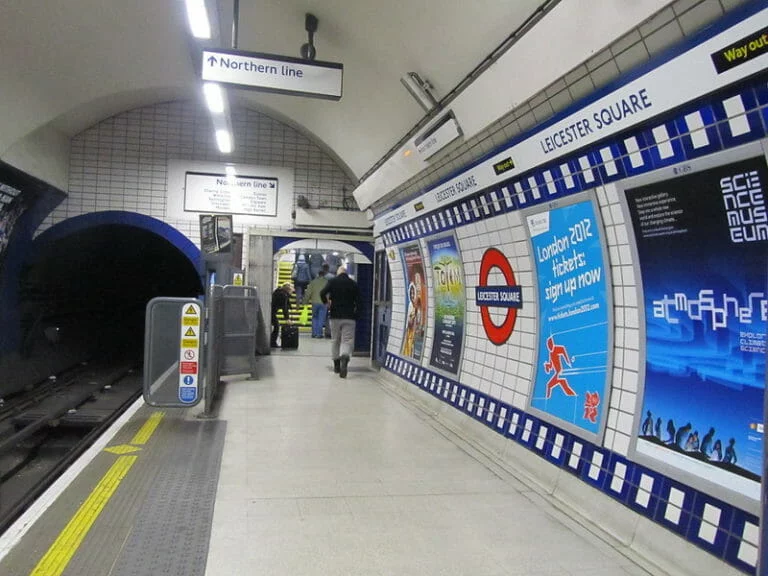
flierfy / Flickr
On all four platforms, film sprockets are painted down the entire length and on the top and bottom of the display area (blue on the Piccadilly line platforms, and black on the Northern line platforms), due to the four premiere cinemas in Leicester Square.
–
Leyton
Is home to one of the most accident-prone stretches of the Underground network: the line between Leyton & Stratford has had several fatal crashes, including one in 1953 in which 12 people died, the worst accident on the tube lines at the time.
–
Leytonstone
Features 17 mosaics of Alfred Hitchcock films & famous moments, since he lived locally.
–
Liverpool Street
Built on the original site of the Bethlehem (Bedlam) mental asylum.
–
London Bridge
Is the only station on the entire London Underground network with the word “London” in its name.
–
Loughton
The station was originally built so that City workers would have easy access to Epping Forest.
–
Maida Vale
When Maida Vale station opened on 6 June 1915 it was entirely staffed by women due to shortages of male staff in the war. It was the first station to have all-female staff.
–
Manor House
Its street-level entrances are in different boroughs: three are in Hackney, and one is in Haringey.
–
Mansion House
Has all five vowels in its name.
–
Marble Arch
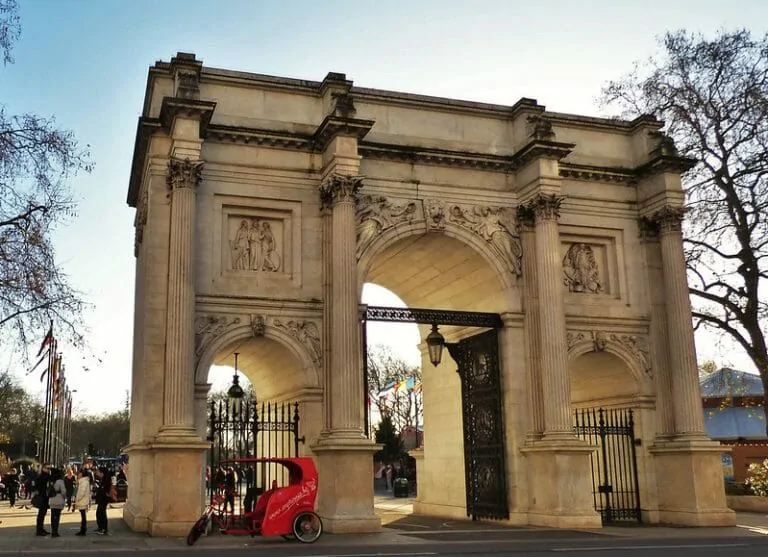
Grassrootsgroundswell / Flickr
The marble arch that it’s named after, and which sits opposite the station was originally going to be the entrance to Buckingham Palace.
–
Marylebone
Very nearly wasn’t built because it might have disturbed the cricket played at Lords. It took an act of parliament to finally push construction through.
–
Mile End
Is named so because it’s exactly one mile from the eastern boundary of The City of London.
–
Mill Hill East
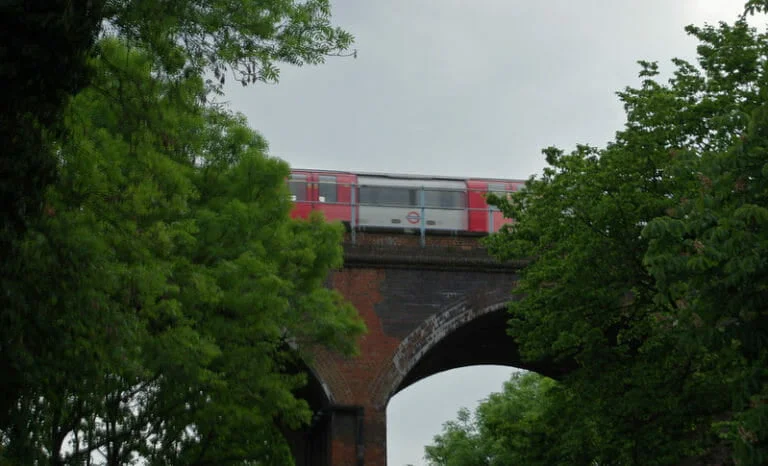
Matt Buck / Flickr
Features a viaduct in which trains travel 18m above ground – the highest point on the Underground network.
–
Monument
Its original name, Eastcheap, lasted precisely one month before it was changed to Monument, after the nearby memorial to the Great Fire of London.
–
Moor Park
Has a “secret” unmarked entrance adjacent to a golf course.
–
Moorgate
Has a little known second underground network/line which starts here – the Northern City Line runs from Moorgate to Finsbury Park, and isn’t run by TFL.
–
Morden
Is the start of the longest tunnel on the Underground network, running 27.8 kilometres (17.3 mi) to East Finchley via the Bank branch.
–
Mornington Crescent
Is the subject of a deliberately incomprehensible gameshow on BBC Radio 4, in which there are no rules.
–
Neasden
The Tube celebrated its centenary here in 1963 with a series of events including a parade of underground trains.
–
Newbury Park

Chris Sampson / Flickr
The bus shelter attached to it is Grade II listed. The station isn’t.
–
North Acton
Station staff regularly participate in Transport for London’s annual Underground in Bloom competition, and in 2010 won first prize in the Fruit and Vegetable category, for their sweetcorn and strawberries.
–
North Ealing
Is not actually north of Ealing, but east of it.
–
North Greenwich
Despite its name, it is not in the area historically known as North Greenwich (which is on the Isle of Dogs, north of the River Thames); an entirely different North Greenwich station used to be there, between 1872 and 1926.
–
North Harrow
Has been awarded the “Best Customer Service” trophy at the London Transport Awards – no surprise, the station master is called James Bond.
–
North Wembley
The safest tube station on the entire network, according to the MET.
–
Northfields
The 5th president of the US, John Quincey Adams, lived next to the site of the station for two years.
–
Northolt

Matt Brown / Flickr
Northala park next door features four man-made hills, constructed from the waste rubble of Wembley stadium.
–
Northwick Park
Is only 350m from Kenton station, making it the closest tube station pair outside zone 1.
–
Northwood
Is actually at a higher level than Northwood Hills.
–
Northwood Hills
Before it opened in 1933, there was a competition to name it. This was, apparently, the winning entry, despite the station being lower than Northwood.
–
Notting Hill Gate
The reason it’s called Notting Hill Gate is because it was literally a gate: it used to be a toll road.
–
Oakwood
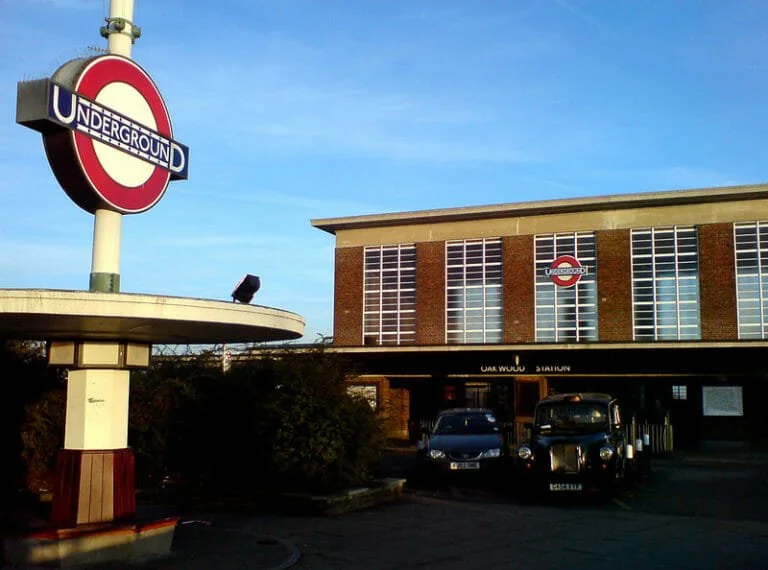
Oliver Mallich / Flickr
The booking hall originally had a plaque claiming that the station occupied ‘the highest point in Europe in a direct line west of the Ural Mountains of Russia’, which is a very strange way of saying that it’s 300 feet above sea level.
–
Old Street
It’s buried in soil so acidic that the cast iron tunnel linings had to be replaced in the ’90s due to corrosion.
–
Osterley
This building replaced the earlier Osterley & Spring Grove station, 300 metres away, which is now Osterley Bookshop. Inside the bookshop the archway to the platforms is still visible, but blocked off, and the platforms behind are still in place.
–
Oval
The first railway station to employ electrified tracks in London.
–
Oxford Circus
In 1969, to celebrate the opening of the new Victoria Line, The Queen ‘took the wheel’ of a train, and drove it from Green Park to Oxford Circus.
–
Paddington
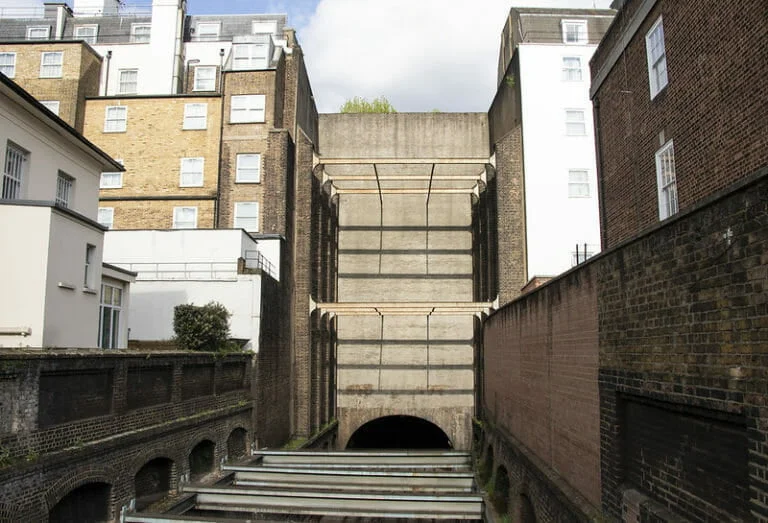
Jeremy Segrott / Flickr
The track running towards Bayswater passes under 23-24 Leinster Road, one of London’s hidden secrets. From the street, they appear to be two houses, but it’s actually just a facade constructed to match the neighbouring terrace houses, disguising where the original building was demolished to allow a gap in the tube system for steam trains to er …let off steam.
–
Park Royal
The station platforms aren’t actually level – they slope up from south to north.
–
Parsons Green
Was designed under the supervision of John Wolfe Barry, the man who engineered Tower Bridge (and whose father designed the Houses of Parliament).
–
Perivale
Is an anagram of “rail peve”.
–
Piccadilly Circus
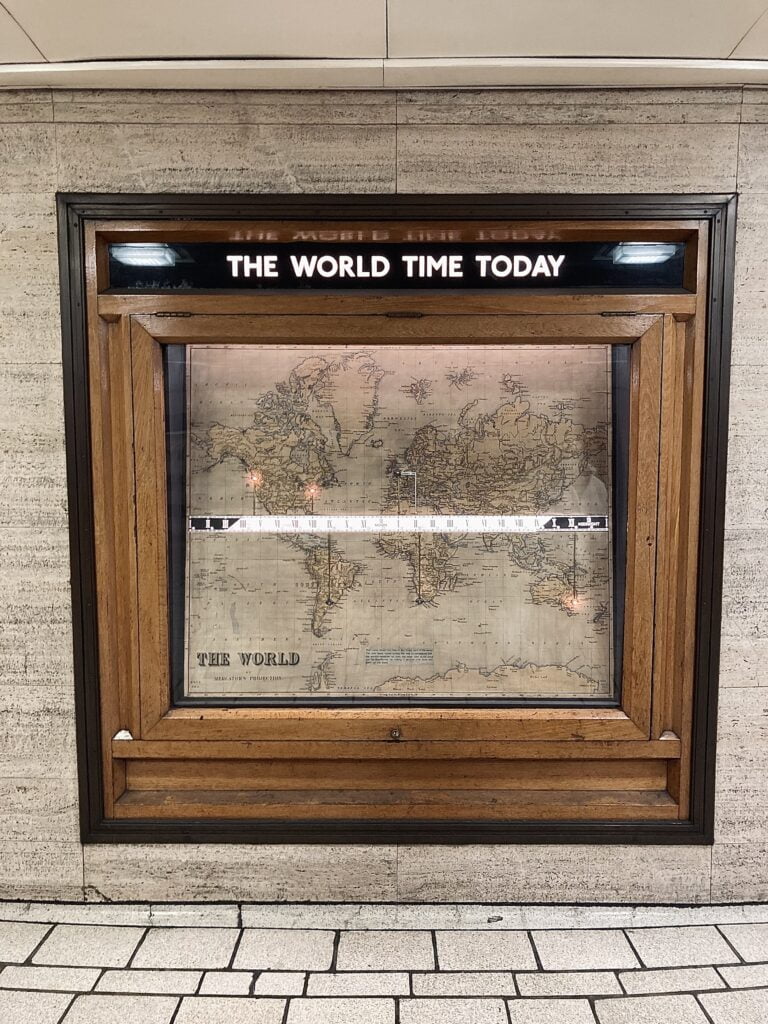
A world map in the station ticket hall, dating from the 1920s, contains a linear clock that shows the time in all parts of the world.
–
Pimlico
Originally named after Ben Pimlico, a Hoxton brewer famous for his nut brown ale. It was so insanely popular with the residents of the area, the place became named after him.
–
Pinner
In 2009, a Pyrenean Mountain Dog named Rufus became a minor celebrity for his daily commute from Pinner to Baker Street due to his enormous size.
–
Plaistow
According to 18th Century writer Aaron Hill, prior to the station being put in, Plaistow was “a whole day’s coach ride” to Westminster. Afterwards, it took less than half an hour.
–
Preston Road
Was originally named “Preston Road Halt for Uxendon and Kenton”, which would have made it easily the longest tube station name on the line, and the only one with an actual instruction.
–
Putney Bridge
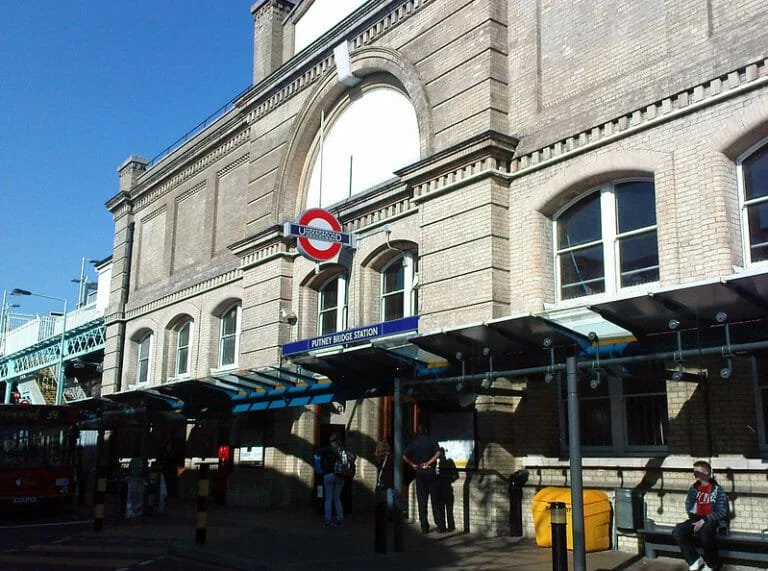
Oliver Mallich / Flickr
It’s not in Putney – it’s on the Fulham side of the Thames. While you’re there, pop into Hurlingham Books on the corner, one of the loveliest second-hand bookshops in London.
–
Queen’s Park
The site of the only “carriage shed” on the tube line: a wooden garden shed-like tunnel that you pass through on the northward part of your journey.
–
Queensbury
The name Queensbury did not, when it was chosen, refer to any pre-existing area. It was coined by analogy with the adjacent Kingsbury station.
–
Queensway
Named Queen’s Road originally (because Queen Victoria was born nearby), but people thought that ‘lacked distinctiveness’, so was changed.
–
Ravenscourt Park
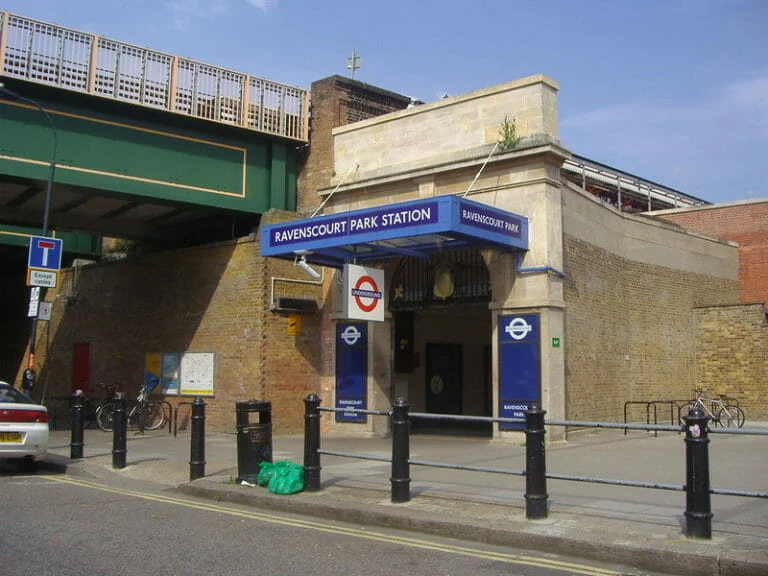
David Howard / Flickr
The least Instagrammed station in London, with zero posts for the whole of 2016.
–
Rayners Lane
When the station first opened, there was only one single house nearby, owned by a farmer named Daniel Rayner. The station was duly called Rayner’s Lane.
–
Redbridge
During WW2, the train tunnels at Redbridge were used as an aircraft parts factory.
–
Regent’s Park
A parliamentary law originally declared that no station could be built at the current site – it was overturned, but there’s still no surface station here.
–
Richmond
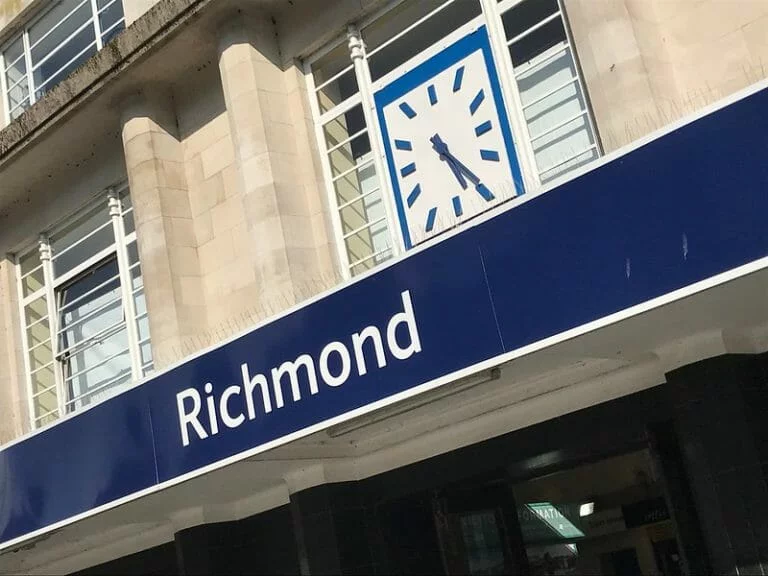
Matt Brown / Flickr
Richmond station is built from Portland Stone, a Jurassic era limestone from Dorset used in the construction of Buckingham Palace, St. Paul’s Cathedral, and the UN Building in New York.
–
Rickmansworth
Is a surprising hub for film locations: scenes for both Indiana Jones and the Raiders of the Lost Ark, and the Last Crusade were filmed literally two minutes north of the station, as well as Bridget Jones and the Edge of Reason, and Blackadder.
–
Roding Valley
The quietest tube station on the line, transporting the same number of passengers in a year as Waterloo does in one day.
–
Royal Oak
Named after a nearby pub (still there, but now called The Porchester).
–
Ruislip
Due to the convoluted tracks, it’s actually possible to reverse trains here, but it takes up both platforms, so it’s not done at peak hours.
–
Ruislip Gardens
The station achieved poetic immortality in Poet Laureate John Betjeman’s poem Middlesex.
–
Ruislip Manor
Suffered heavy aerial bombardment by the Luftwaffe during WW2, due to its proximity to RAF Northholt.
–
Russell Square
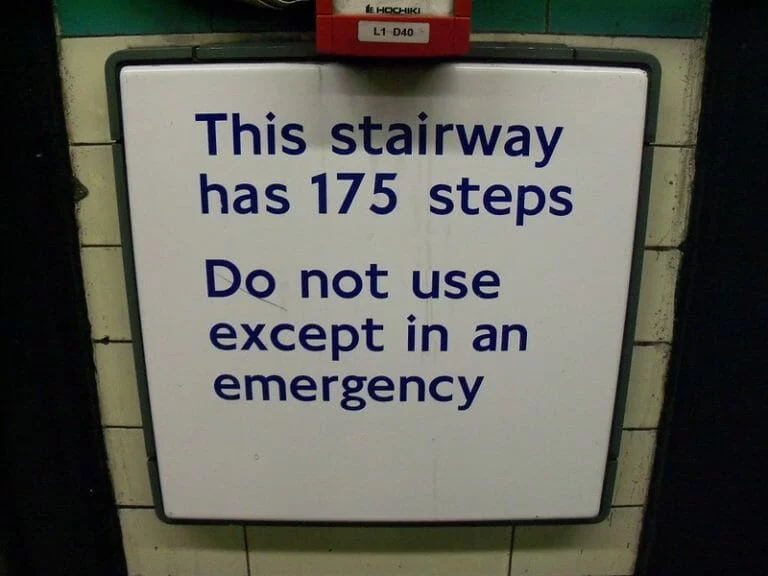
Lisa / Flickr
The sign lists the number of steps as 175. There are in fact, 171. Quite why no-one double checked is a mystery.
–
Seven Sisters
Named after seven elm trees which have stood in the neighbourhood since the 1730s. The current trees were planted by five families of seven sisters.
–
Shepherd’s Bush
This tube station has no lifts because, due to nearby utilities, they would cost £100m to install. Adjusted for inflation, that’s about half the cost of the construction of entire Metropolitan Line.
–
Shepherd’s Bush Market
Until 2008, it was also called Shepherd’s Bush, until it was renamed to avoid confusion.
–
Sloane Square
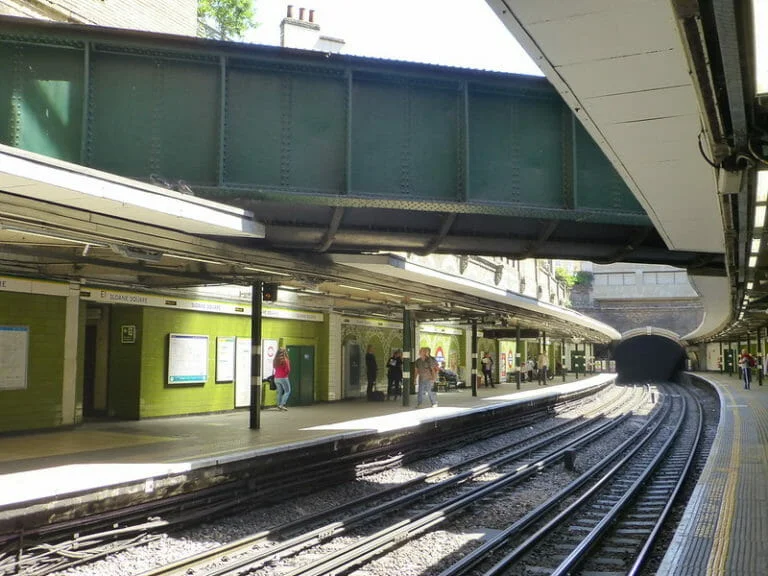
City Transport Info / Flickr
The River Westbourne literally runs through the station – it was redirected through its own little bridge suspended over the main platform.
–
Snaresbrook
Most of the station’s Victorian features remain today, including brick buildings, extensive cast iron, and timber canopies.
–
South Ealing
Has all five vowels in its name.
–
South Harrow
The train actually travels over a marsh north of the tube station. It crosses it via aquaduct.
–
South Kensington
Between South Kensington and Knightsbridge, the tube steers away from following the road above it in order to avoid a large plague pit.
–
South Kenton
Its platform was built too high for the trains, and never corrected.
–
South Ruislip
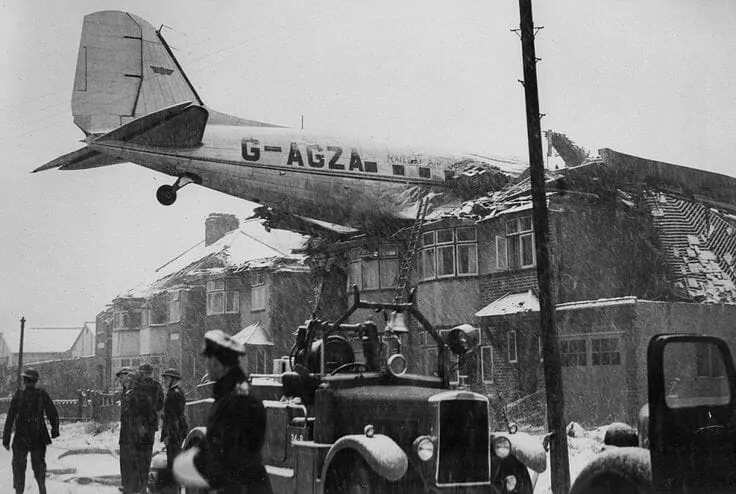
Alan Farrow / Flickr
In 1946, an aeroplane with ice on its wings crashed into a nearby house, but thanks to the skill of the pilot, essentially landed neatly on the roof. Despite their being 5 people aboard, and a toddler asleep in the top floor of the house, no-one was even injured. The crew & passengers simply went down through the loft, and came out the front door of the house.
–
South Wimbledon
Opening in 1926, the originally proposed name was Merton Grove, but it was renamed South Wimbledon to try and sound classier.
–
South Woodford
The only station in which the name on the station’s own roundels is different to the official name – they call it South Woodford (George Lane).
–
Southfields

Alvin Leong / Flickr
The station platform undergoes a makeover each year to coincide with the Wimbledon tennis tournament. Wimbledon station doesn’t.
–
Southgate
When it first opened, local residents were given a free return ticket to Piccadilly Circus to encourage them to use the service.
–
Southwark
Southwark Station’s blue cone wall, built as part of the Jubilee line extension’s new generation of stations, was inspired by an 1816 stage set for The Magic Flute.
–
St. James’s Park
Is a Grade I listed building, making station improvements considerably difficult. In fact, it’s the only Grade I listed station (although Bank has a Grade I listed entrance).
–
St. John’s Wood
The only station on the Underground network not to share any letters with the word “mackerel”.
–
St. Paul’s
During the Second World War, the electricity grid control room for the entire of London and Southeast England was housed here, in the lift shaft.
–
Stamford Brook
The first tube station to have an automatic ticket barrier installed on 5 January 1964.
–
Stanmore

David Howard / Flickr (edited)
Was a secret outstation for Bletchley Park during WW2 – in fact, the crosswords decorating the station house are a reference to the test WW2 codebreakers had to pass to qualify for consideration: completing the Times crossword in under 12 minutes.
–
Stepney Green
A Tudor-era bowling ball was unearthed during the Crossrail excavations under the station.
–
Stockwell
Just below the station platforms, there is an air raid shelter comprised of two tunnels, both six times the length of the platforms themselves. They’re currently used as a secure archive.
–
Stonebridge Park
The booking hall is the only original feature – the rest has been destroyed by WW2 bombing, and two major fires.
–
Stratford
Has the shortest escalator on the network, with a vertical rise of 4.1m.
–
Sudbury Hill
This tube station is said to have one of the highest levels of ‘pigeon customers’ in the whole London Underground network. Staff often have to chase large numbers of the birds out of the ticket hall.
–
Sudbury Town
Has a barometer hanging above the ticket hall from the 1930s – in fact, it’s the only station with a barometer still in it.
–
Swiss Cottage
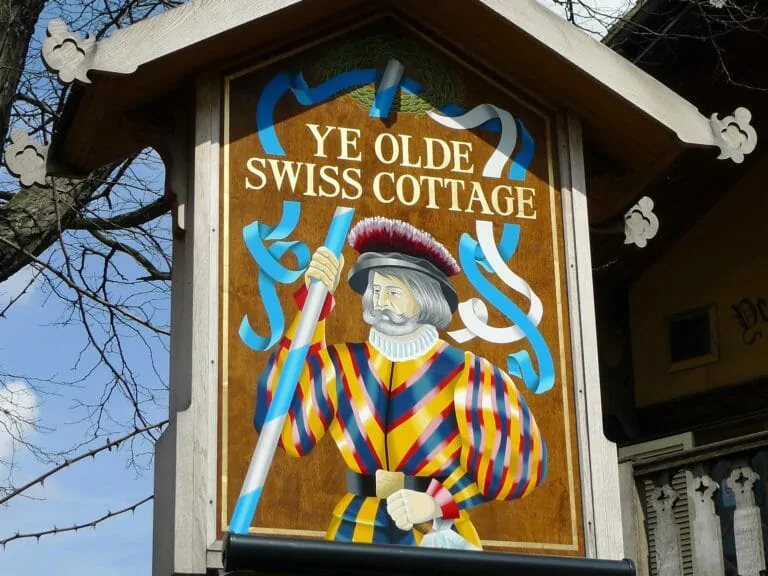
Ewan Munro / Flickr (edited)
Named after the nearby pub, built in 1840 when a craze for Swiss cottages was sweeping Victorian Britain.
–
Temple
On the columns at Temple station, there are small temple-shaped emblems at the bases.
–
Theydon Bois
Is the only part of Theydon Bois that has street lighting – the rest of the town has none in order to maintain ambiance.
–
Tooting Bec
Has a crater on Mars named after it.
–
Tooting Broadway

Ian Wright / Flickr
The big statue of Edward VII at the entrance was paid for entirely by the public when it was made in 1911.
–
Tottenham Court Road
Was originally called Oxford Street (before Oxford Circus opened).
–
Tottenham Hale
Has been the site of no less than five collisions & derailments.
–
Totteridge & Whetstone
Was originally named ‘Whetstone and Totteridge’, owing to the fact that it is in Whetstone. But the name was switched, for reasons we still can’t tell.
–
Tower Hill
If you stand on the eastern end of the westbound platform, and look up near the ceiling you’ll be able to see one of the longest stretches of the London Wall built by the Romans to surrounded the City of London still in existence.
–
Tufnell Park
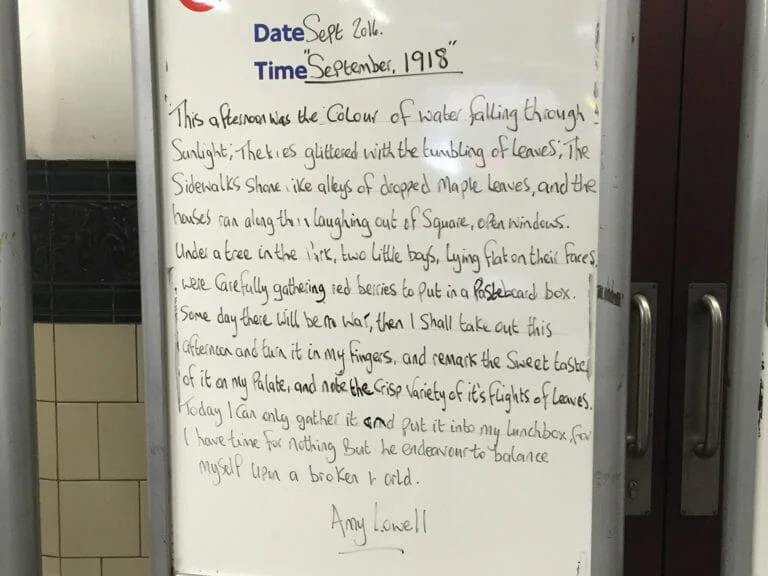
Matt Brown / Flickr
On the service board at Tufnell Park station you’ll find ‘Poetry Corner’, the station staff’s daily selection of poetry by local residents, school children and famous poets, ‘giving passengers something to read while they’re waiting for the lifts’.
–
Turnham Green
Wheeler’s Florist, based directly outside the station, has provided flowers for Bond & Batman movies. Which, apparently, had flowers in them.
–
Turnpike Lane
The name ‘Turnpike Lane’ refers to a toll gate erected there in 1767. And of course, the tube barriers there now technically are a toll gate, meaning the name is still accurate.
–
Upminster
The speed of sound was first accurately measured from a church about half a mile from the station.
–
Upminster Bridge
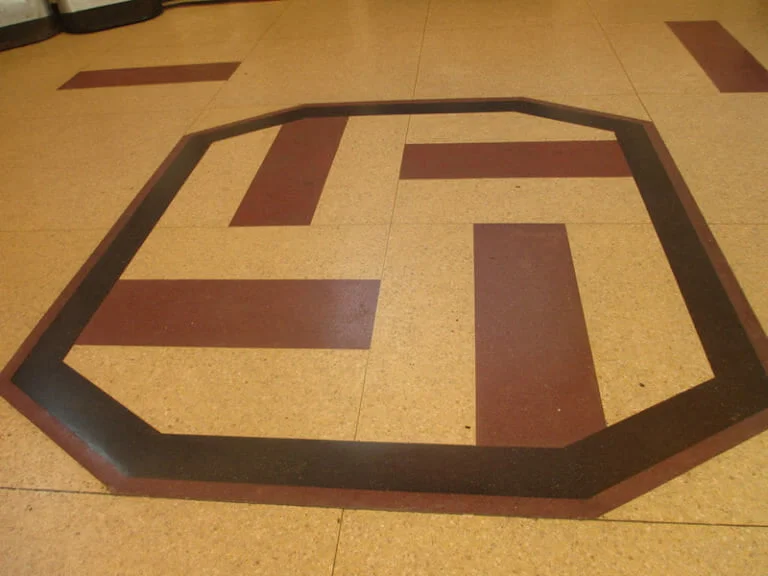
Matt Brown / Flickr
Somewhat unnervingly, has a swastika pattern on the floor. However, the station predates the Nazis’ commandeering of the ancient symbol of good luck, which used to be a relatively common architectural emblem.
–
Upney
The Gunpowder Plot was hatched in a manor house next to the station.
–
Upton Park
The station’s name is cockney slang for crazy (because they’re ‘two stops short of Barking’).
–
Uxbridge
Being the final/first station on the line, has a tunnel designed to mirror the one at Cockfosters at the opposing end of the line.
–
Vauxhall
Thanks to the creamery next door, it used to run daily ‘milk trains’ entirely filled with the white stuff. They would pull into the tube station, and pour their contents into a discharge pipe that led directly to the creamery.
–
Victoria
Plays a key role in Oscar Wilde’s The Importance of Being Earnest – the main character was discovered as a baby in a handbag in the station.
–
Walthamstow Central
Originally called ‘Hoe Street’.
–
Wanstead
The tunnels between Wanstead and Gants Hill to the east were turned into munitions factories during WW2.
–
Warren Street

IMDB / Blue Underground
Used as the location for the 1972 British horror film, Death Line, which featured a family of cannibals living on the London Underground.
–
Warwick Avenue
A song named after it by singer Duffy reached number 3 in the charts.
–
Waterloo
Has 23 escalators, the most of any tube station on the network.
–
Watford
Due to not being in the centre of town, has been threatened with closure since 1927.
–
Wembley Central
Despite servicing Wembley Stadium, is only the 142nd busiest station on the line.
–
Wembley Park
Was originally constructed to serve Wembley Pleasure Grounds, which were to be centrepieced by a tower taller than the Eiffel Tower.
–
West Acton
The original 1923 station was rebuilt by 1940 – and it’s now Grade II listed.
–
West Brompton
The Overground lines here were built in 1866 (before the district line) as part of the West London Line – which was closed between 1940 and 1999 due to WWII bombing.
–
West Finchley

Ian Wright / Flickr
Made predominantly from fittings taken from other stations in the North of England. The bridge apparently came from Yorkshire.
–
West Ham
Has more platforms (8) than Charing Cross (6).
–
West Hampstead
Was originally known as “West End” until the name was changed in order to avoid confusion with, well, the West End.
–
West Harrow
Is, perhaps ironically, the station people travel to in order to get to Britain’s biggest walking festival.
–
West Kensington
Being next to the Queen’s Club, it’s 5x closer to a grass tennis court than Wimbledon station.
–
West Ruislip
The longest journey you can take without a change on the entire Underground network is the 37 miles from West Ruislip to Epping.
–
Westbourne Park
Was the first station to be demolished. It was relocated in 1871.
–
Westminster
Excavations for creating the deep level Jubilee line platforms caused Big Ben to move 35 millimetres. Any more, and the tower would have cracked and possibly collapsed.
–
White City
Replaced an earlier station that was called Wood Lane that had been there since 1864. Then, in 2008, they opened a new station down the road called Wood Lane.
–
Whitechapel
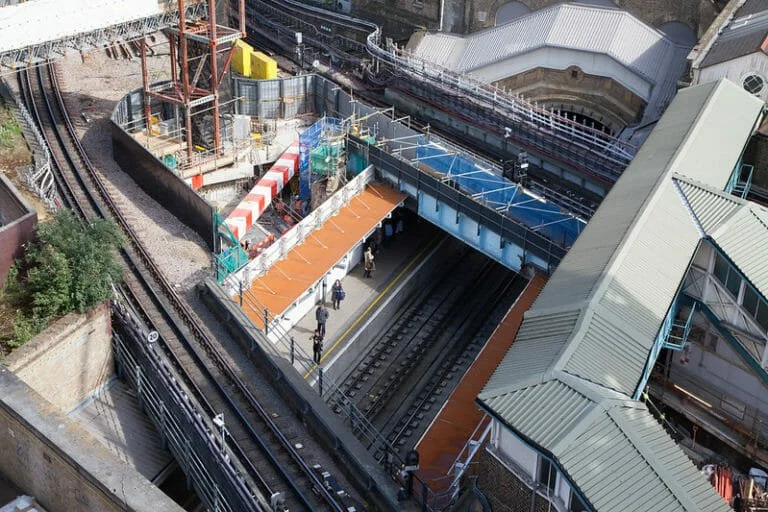
Tom Page / Flickr
Whitechapel is the only place on the network where the Overground runs below the Underground.
–
Willesden Green
When he was mayor, Ken Livingstone used to get the tube to work from here every day.
–
Willesden Junction
In 1896 staff totalled 271, including 79 porters, 58 signalmen (in 14 signal boxes) and 58 shunters and yard foremen.
–
Wimbledon
Laddie the Airedale Terrier was based at the station as a fare collector for six years, before retiring in 1956. During his time there, he collected £5,000 pounds in the change box on his back.
–
Wimbledon Park
Despite being the closest station to the All England Club, is still closer to Wimbledon golf club than the tennis club.
–
Wood Green
Gets name-dropped in songs by Razorlight (Los Angeles Waltz), Mark Knopfler (Junkie Doll), Pablo Gad (Black Before Creation), and Sway DaSafo (Up Your Speed).
–
Wood Lane
Was the first station to be added to a tube line for 70 years when it opened in October 2008.
–
Woodford
A wooden owl was put into the station’s rafters during recent refurbishment as a reference to the owl sanctuary nearby.
–
Woodside Park
Alphabetically, the last name on the entire Tube network.
–
If you enjoyed these tube facts… you’ve got to visit an abandoned tube station with the London Transport Museum’s Hidden London tours.
